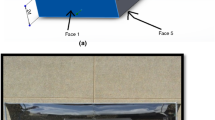Abstract
Solar still is a promising device used worldwide for water distillation due to its simple design, easy construction and low cost. However, the freshwater output from a solar still is moderate. Several active techniques have been emerged over the years to solve this problem. In this paper, an experimental study is carried out on a single-slope solar still augmented with an evacuated tube collector (ETC) and a heat exchanger working on thermosyphon. The effects of shading and evaporative cooling of glass cover on the active solar still performance were explored and analyzed on separate days under the meteorological conditions of Kurukshetra, India. The experiments were conducted at a constant water depth of 4 cm. The main aim of this study is to enhance the productivity and efficiency of ETC-coupled solar still by increasing the condensation rate. The experimental results showed remarkable increment in freshwater productivity of the still with a maximum of 2114 ml/day achieved for the case of ½ shading and cooling of glass cover. An increase of 16.4% and 3.8% in freshwater productivity and overall efficiency was achieved with ½ shading and cooling of glass cover in comparison with solar still without glass cover shading and cooling. The solar still performance was decreased when the shading and cooling are done on more than half the area of glass cover.




















Similar content being viewed by others
References
Abderachid, T., & Abdenacer, K. (2015). The effect of cover tilt angle of a double slope solar still on the productivity in summer and winter seasons. Desalination and Water Treatment,56(10), 2584–2592.
Ali, C., Rabhi, K., et al. (2015). Theoretical and experimental analysis of pin fins absorber solar still. Desalination and Water Treatment,56(7), 1705–1711.
Arjunan, T., Aybar, H., et al. (2011). Effect of sponge liner on the internal heat transfer coefficients in a simple solar still. Desalination and Water Treatment,29(1–3), 271–284.
Bacha, H. B., & Zhani, K. (2013). Contributing to the improvement of the production of solar still. Desalination and Water Treatment,51(4–6), 1310–1318.
Bani-Hani, E., Qassem, H., et al. (2017). Experimental analysis of an improved solar still system with cooling fan and preheating oil. Energy Engineering,114(5), 55–71.
Chandrashekara, M., & Yadav, A. (2017). Water desalination system using solar heat: A review. Renewable and Sustainable Energy Reviews,67, 1308–1330.
Elango, T., & Murugavel, K. K. (2015). The effect of the water depth on the productivity for single and double basin double slope glass solar stills. Desalination,359, 82–91.
El-Naggar, M., El-Sebaii, A., et al. (2016). Experimental and theoretical performance of finned-single effect solar still. Desalination and Water Treatment,57(37), 17151–17166.
Gnanaraj, S. J. P., Ramachandran, S., et al. (2018). Enhancing the productivity of double-slope single-basin solar still with internal and external modifications. International Journal of Ambient Energy,39(8), 777–782.
Haddad, Z., Chaker, A., et al. (2017). Improving the basin type solar still performances using a vertical rotating wick. Desalination,418, 71–78.
Hansen, R. S., Narayanan, C. S., et al. (2015). Performance analysis on inclined solar still with different new wick materials and wire mesh. Desalination,358, 1–8.
Holman, J. P., & Gajda, W. J. (2001). Experimental methods for engineers. New York: McGraw-Hill.
Hosseini, A., Banakar, A., et al. (2018). Development and performance evaluation of an active solar distillation system integrated with a vacuum-type heat exchanger. Desalination,435, 45–59.
Issa, R. J., & Chang, B. (2017). Performance study on evacuated tubular collector coupled solar still in West Texas climate. International Journal of Green Energy,14(10), 793–800.
Karthick Munisamy, T., Mohan, A., et al. (2017). Experimental investigation of tilted wick solar still using fabrics. Australian Journal of Mechanical Engineering, 13(2), 1–6.
Mehla, N., & Yadav, A. (2017). Experimental analysis of thermal performance of evacuated tube solar air collector with phase change material for sunshine and off-sunshine hours. International Journal of Ambient Energy,38(2), 130–145.
Morad, M., El-Maghawry, H. A., et al. (2015). Improving the double slope solar still performance by using flat-plate solar collector and cooling glass cover. Desalination,373, 1–9.
Nagarajan, P., El-Agouz, S., et al. (2017). Effect of forced cover cooling technique on a triangular pyramid solar still. International Journal of Ambient Energy,38(6), 597–604.
Omara, Z., & Eltawil, M. A. (2013). Hybrid of solar dish concentrator, new boiler and simple solar collector for brackish water desalination. Desalination,326, 62–68.
Sharshir, S., Peng, G., et al. (2017). Enhancing the solar still performance using nanofluids and glass cover cooling: Experimental study. Applied Thermal Engineering,113, 684–693.
Srithar, K. (2003). Studies on solar augmented evaporation systems for tannery effluent (Soak liquor). Ph.D. thesis, Indian Institute of Technology, Madras.
Suneesh, P., Jayaprakash, R., et al. (2014). Effect of air flow on “V” type solar still with cotton gauze cooling. Desalination,337, 1–5.
Winston, D. P., Pounraj, P., et al. (2018). Experimental investigation on hybrid PV/T active solar still with effective heating and cover cooling method. Desalination,435, 140–151.
Yadav, A., & Bajpai, V. (2012). Thermal performance of one-ended evacuated tube solar air collector at different flow rates: Experimental investigation. International Journal of Ambient Energy,33(1), 35–50.
Author information
Authors and Affiliations
Corresponding author
Additional information
Publisher's Note
Springer Nature remains neutral with regard to jurisdictional claims in published maps and institutional affiliations.
Rights and permissions
About this article
Cite this article
Bhargva, M., Yadav, A. Effect of shading and evaporative cooling of glass cover on the performance of evacuated tube-augmented solar still. Environ Dev Sustain 22, 4125–4143 (2020). https://doi.org/10.1007/s10668-019-00375-8
Received:
Accepted:
Published:
Issue Date:
DOI: https://doi.org/10.1007/s10668-019-00375-8




